INK AI Tool Review 2025: Features, Use Cases, Pricing & Top Alternatives Compared
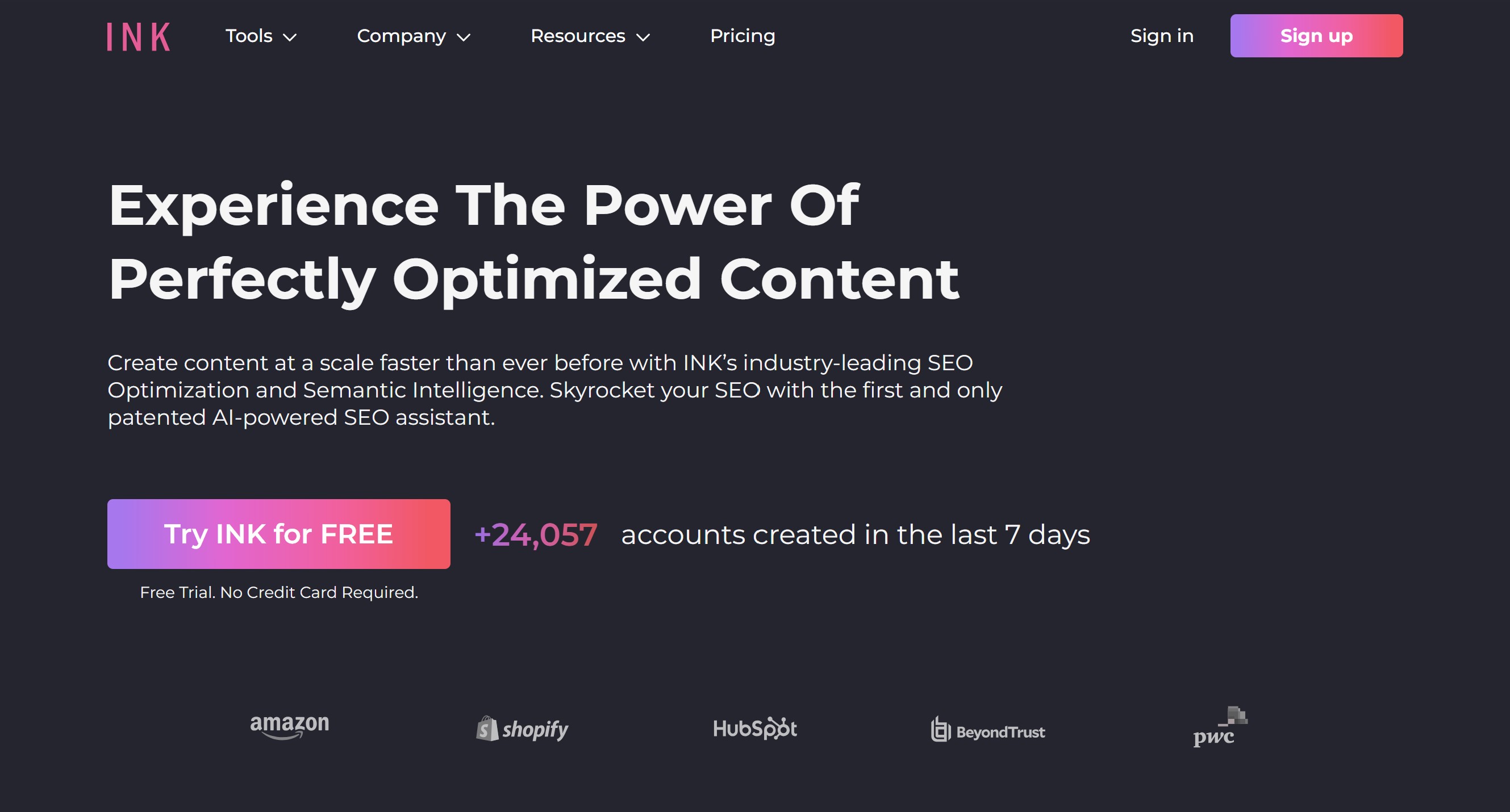
The demand for AI-powered content tools is growing rapidly, and the INK AI tool has carved a unique space in that landscape.
Unlike many AI writers focused solely on content generation, INK brings a powerful blend of writing and SEO optimization into one unified platform.
In this INK AI tool review, I’ll walk you through what sets it apart from its competitors—and why many marketers and content creators are making the switch.
Whether you're a beginner exploring your first AI writing app or a digital marketing pro, INK’s features are designed to improve your writing speed and ranking potential.
Its built-in SEO Assistant, distraction-free editor, and grammar tool help you stay productive while maintaining high-quality standards.
From blog writing to social captions, the AI-powered INK AI tool adapts to your workflow and content goals.
This review explores its features, pricing, strengths, and top INK AI tool alternatives for 2025 and beyond.
1. What Is INK AI?
The INK AI tool is an AI-powered writing and SEO assistant designed to help content creators produce high-quality, optimized content faster. It combines natural language generation with real-time SEO scoring, making it a dual-purpose platform for both creativity and discoverability.
Unlike standard writing software, INK is purpose-built to help your content rank higher in search engines while maintaining readability and tone. Its AI engine doesn’t just assist with grammar and style—it proactively guides users through optimization techniques, keyword usage, and structure enhancements as they write.
At its core, INK features three main capabilities: the AI Writer, the SEO Assistant, and the Content Shield. The AI Writer generates short- and long-form copy based on prompts, while the SEO Assistant scores your content live and recommends real-time improvements. The Content Shield checks for originality and readability, reducing the risk of low-quality or duplicate content.
The AI-powered INK AI tool is best suited for bloggers, content marketers, SEO professionals, and growing teams that need to scale content without sacrificing search performance. It’s also beginner-friendly, making it an ideal choice for creators who want to start producing content that performs without a steep learning curve.
2. INK AI Tool Features Breakdown
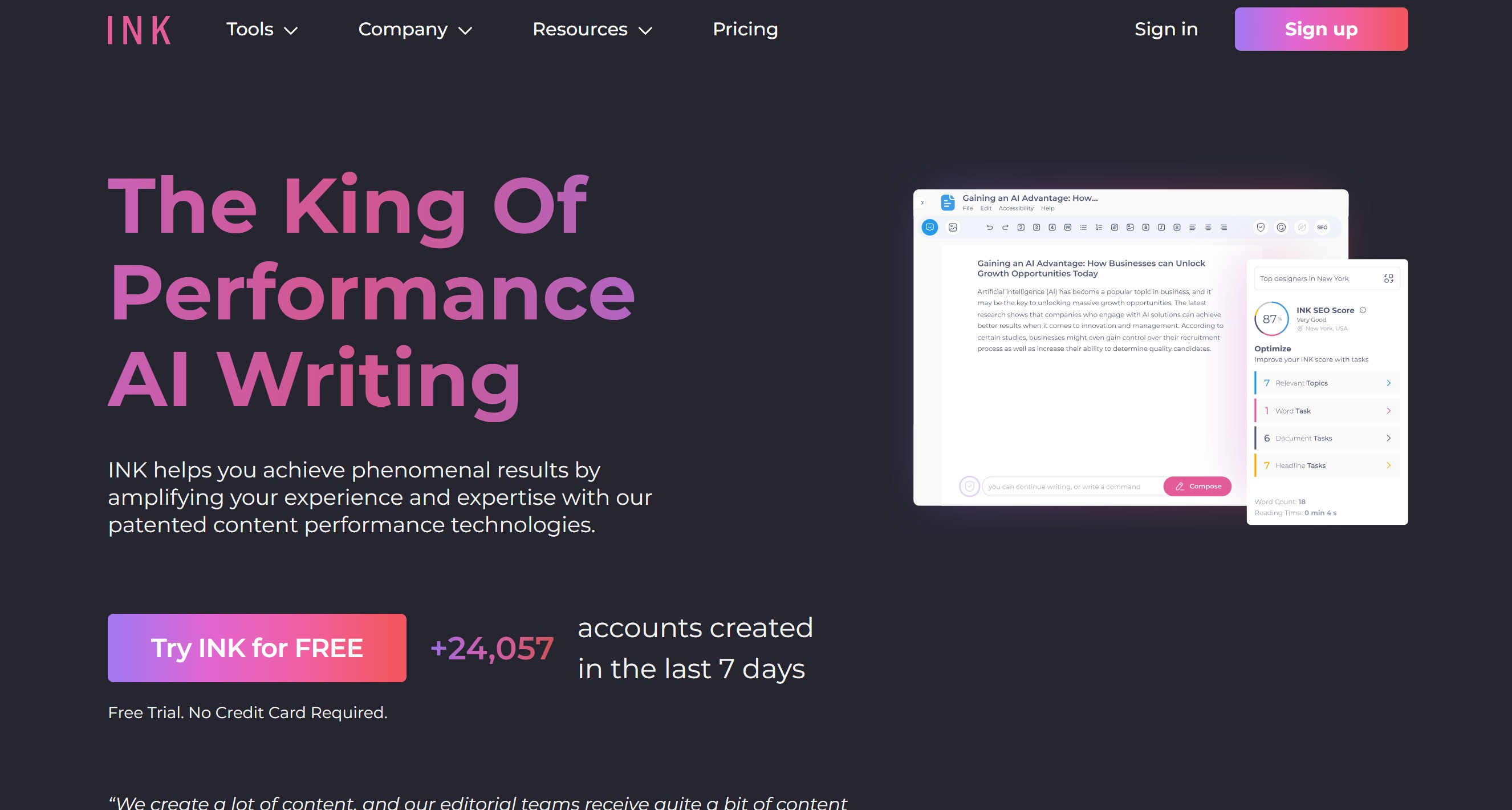
INK AI is packed with intelligent features that streamline content creation while improving your chances of ranking on search engines.
It offers a distraction-free editor that combines AI writing with SEO analysis in one clean interface.
The SEO Assistant provides a real-time optimization score that adjusts as you write.
This score helps guide word count, semantic keywords, headings, and readability to match current search intent.
The AI Writer uses advanced GPT-based technology to produce headlines, blog intros, product descriptions, and more.
It responds to short prompts and offers variations that align with your tone and writing goals.
Content Shield ensures content originality and checks for grammatical, tonal, and structural errors.
INK integrates a Chrome extension that allows on-the-go optimization and writing directly within tools like WordPress, Google Docs, and email platforms.
You can also collaborate with teammates using INK’s cloud platform, enabling shared access to documents, brand voice tools, and optimization benchmarks.
The INK AI tool app is browser-based, meaning there's no need for installation and your workspace is always synced.
One standout feature is Keyword Recommendations, which help users add semantically relevant phrases that improve content structure and SEO naturally.
The tool provides visual cues and metrics like keyword density, intent alignment, and competitor benchmarking.
INK also comes with built-in content templates that support ad copy, landing pages, and social media content creation.
Its AI-powered writing engine includes tone presets—professional, casual, friendly, persuasive—so writers can stay on-brand without manually rewriting output.
INK has an intuitive progress meter that encourages users to reach their optimization goals in a gamified manner.
For agencies and teams, there are collaborative folders and access control features that streamline client approvals and editorial workflows.
With regular updates and new template releases, INK remains a robust and scalable option in the competitive space of AI writing tools.
Compared to traditional writing software, INK’s real-time feedback and SEO focus significantly reduce revision cycles.
It’s not just about writing faster—it’s about writing smarter with data-backed insights and better performance outcomes.
3. INK AI Use Cases in Real-World Scenarios
The versatility of the INK AI tool becomes most evident when you see how it's applied across different content workflows. Whether you’re a solo blogger or managing a marketing team, the platform helps speed up tasks that would otherwise take hours.
For blog writing, INK provides guided templates that help users build out intros, outlines, and SEO-optimized body paragraphs. Writers can feed in a topic and receive multiple, structured options tailored to search engine guidelines. This helps keep output consistent while staying aligned with keyword intent.
In eCommerce, the tool is used to create engaging product descriptions that include target keywords without sounding robotic. Marketers can generate hundreds of variations for A/B testing or multilingual campaigns, cutting turnaround time dramatically.
Ad copy and social media captions benefit from INK’s tone control and length optimization. Its character count feedback is especially useful for paid media campaigns where space is limited but impact is key.
Teams use INK collaboratively to create large volumes of content with consistency in voice, style, and structure. Shared folders and document scoring ensure that editors and writers stay on the same page without endless revisions.
For beginners, the platform offers an intuitive layout, live guidance, and low-friction onboarding—making it ideal for those just learning SEO or content writing best practices.
Meanwhile, advanced marketing teams will appreciate INK’s deeper tools like competitor SERP analysis, intent mapping, and in-line keyword suggestions. These features help optimize content strategy, not just execution.
In my own content workflow, INK has consistently helped reduce draft-to-publish times while improving content performance. Whether you're aiming for quality, speed, or scalability, it's a practical solution that adapts to your needs.
4. INK AI Pricing & Plans
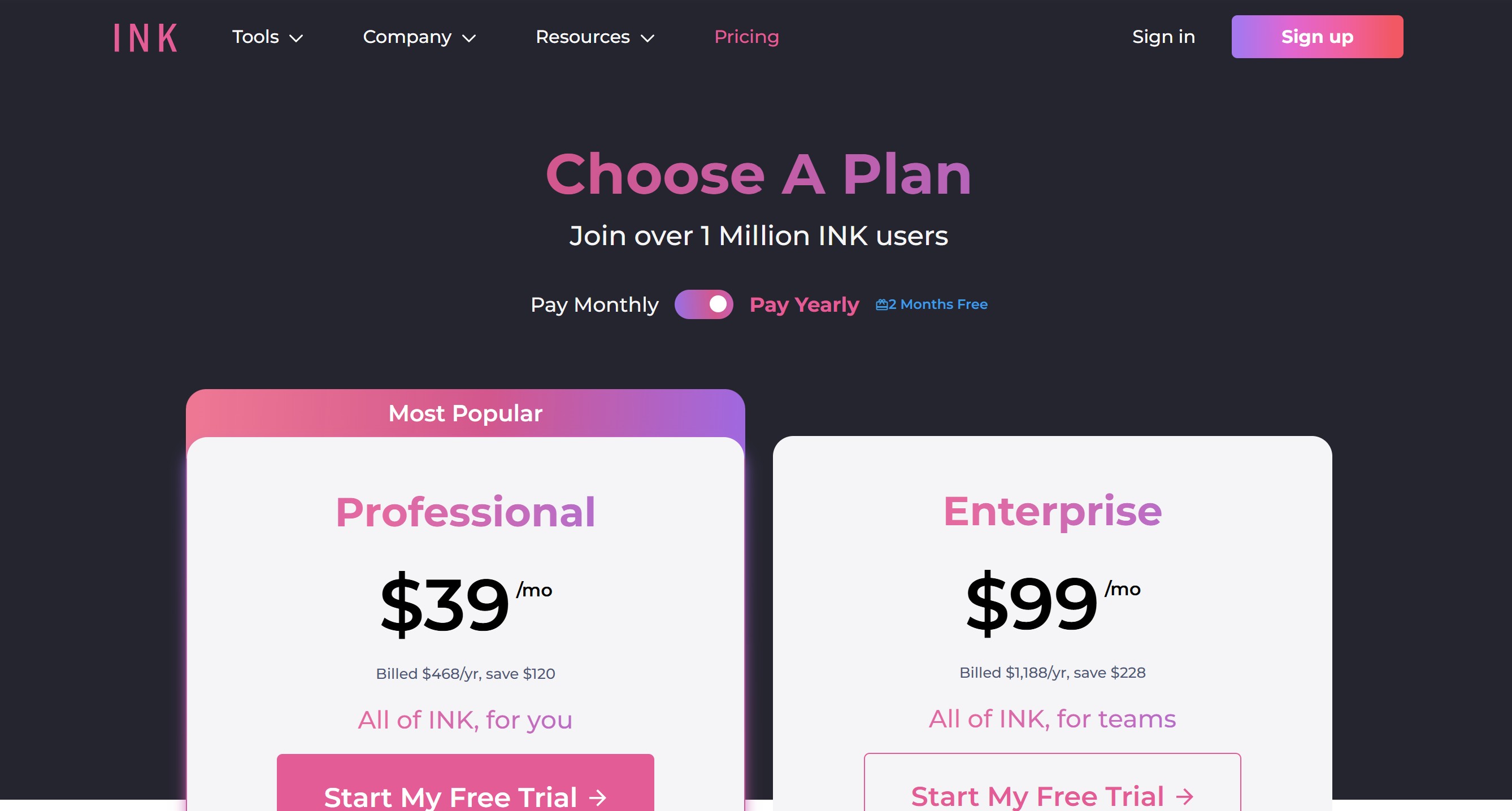
The INK AI tool offers a flexible pricing structure designed to serve beginners, freelancers, and enterprise teams. It includes a free version that allows users to test core features before committing to a paid subscription. This freemium approach makes INK AI accessible for those exploring AI-powered writing tools without initial investment.
The free plan includes access to limited SEO scoring, basic content templates, and AI writing capabilities. It's ideal for casual bloggers or small businesses testing the waters of automated content creation.
For users who need more scale and functionality, INK offers paid subscriptions:
- Professional Plan (approx. $39/month): Full SEO score access, advanced templates, Content Shield, and higher usage limits.
- Enterprise Plan: Custom pricing for large teams, collaboration tools, team performance insights, and priority support.
Key Comparison:Plan
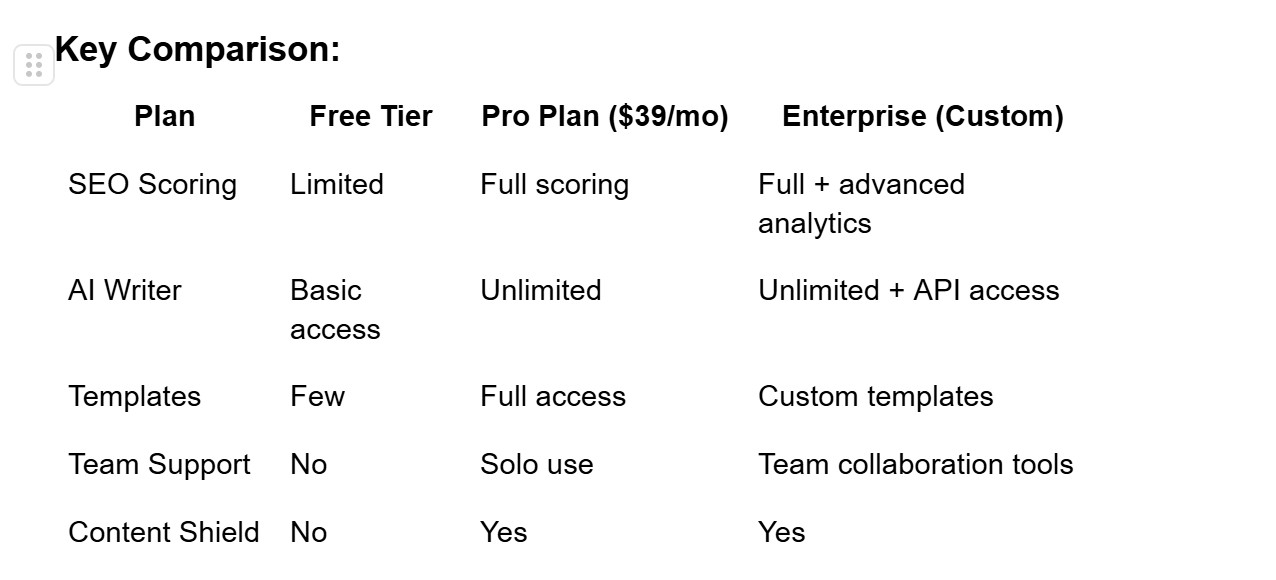
INK’s pricing model is competitive when compared to tools like Jasper or Writesonic, especially considering its SEO-first approach. For freelancers, it offers enough power at an affordable rate. For agencies or teams, the custom features and reporting tools add strong collaborative value.
5. Pros and Cons of INK AI Tool
INK AI excels in combining SEO optimization with AI writing in a user-friendly interface.
The tool provides real-time SEO scoring alongside generated content.
Its writing suggestions are intelligent and optimized for readability.
The design is clean and supports distraction-free writing environments.
INK offers an impressive range of templates for blogs, ads, and social posts.
Its tone detection and adjustment capabilities help writers stay on-brand.
The INK AI tool is cloud-based and accessible via browser and Chrome extension.
The integration of Content Shield is a standout feature, protecting against duplication.
Users benefit from gamified SEO improvement goals which make optimization intuitive.
Its learning curve is minimal, making it ideal for beginners or busy teams.
However, the tool is not without its limitations.
INK sometimes produces repetitive phrases, especially in long-form outputs.
There’s limited control over AI memory or continuity in multi-paragraph writing.
Customization options for brand tone are not as in-depth as Jasper’s.
The free plan has usage limits that advanced users will quickly outgrow.
Collaboration features, while useful, are gated behind the higher-tier plans.
Also, there’s no native integration with third-party SEO tools like Surfer or Semrush.
Still, based on my experience, the affordable INK AI tool remains a solid option for quality content production with built-in SEO feedback.
It may not replace human editing, but it significantly reduces time spent ideating and optimizing.
6. INK AI Tool Comparison with Other AI Tools
When comparing INK AI to other leading AI writing tools, several distinctions become clear. INK is unique in its integration of real-time SEO optimization and content scoring, setting it apart from tools that focus solely on content generation.
Jasper is a strong contender with more advanced memory features and content workflows, ideal for teams producing long-form or branded content. However, it comes at a higher cost and has a steeper learning curve.
Copy AI excels in short-form generation like social media posts and ad copy. It’s beginner-friendly but lacks INK’s SEO scoring capabilities.
Scalenut offers detailed keyword clustering and content planning, which can be helpful for SEO-heavy strategies. Still, it’s more complex and less intuitive for casual users.
Writesonic blends copywriting with long-form content generation and includes chatbot-like functionality (Chatsonic), but its SEO feedback is less actionable than INK’s.
Feature Comparison Table:
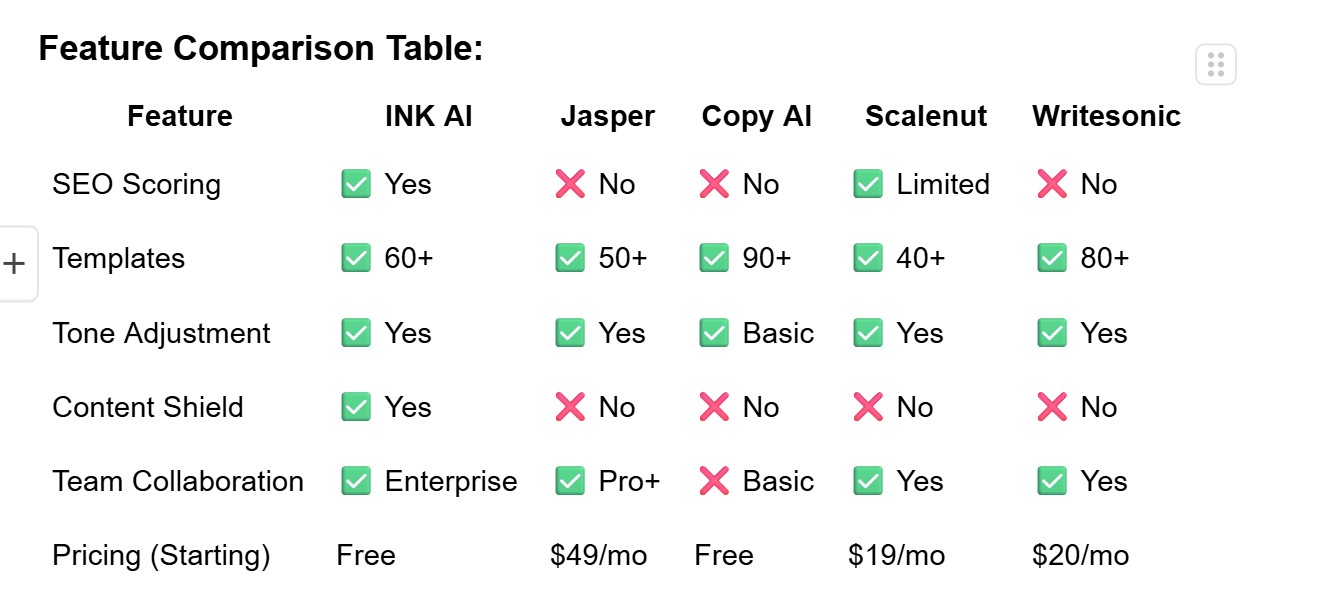
In summary:
- Choose INK AI for SEO-driven writers who want real-time feedback.
- Choose Jasper for team-based, long-form, branded content.
- Choose Copy AI for speed and ease with social copy and headlines.
- Choose Scalenut for keyword planning and in-depth SEO workflows.
- Choose Writesonic for a hybrid of copywriting and chatbot ideation.
7. Best INK AI Tool Alternatives
While INK AI delivers strong value, there are alternatives worth considering depending on your content goals and workflow needs.
Jasper AI remains the best alternative for in-depth, long-form writing and content team workflows. It supports memory, tone, and document organization across multiple campaigns.
Writesonic offers versatility across short and long content with tools like Chatsonic and Surfer SEO integration (on premium plans). It's more feature-rich but can be overwhelming for new users.
Copy AI is the go-to for fast, templated copy creation—think social media, ads, and email. It’s quick to learn and ideal for marketers or business owners without SEO-heavy needs.
Scalenut brings powerful SEO planning features including topic clusters, competition insights, and AI brief generation. It’s excellent for agencies and SEO pros but requires more setup.
Rytr is a low-cost solution for creators on a tight budget. It doesn’t match INK’s SEO intelligence but performs well in generating basic content.
When choosing among top INK AI tool alternatives, your decision should be based on three key factors: SEO needs, team collaboration requirements, and budget flexibility. For SEO-conscious writers who want clean content and guidance in real-time, INK still holds its edge. But for content teams scaling at volume or needing more integrations, other platforms may better suit your workflow.
8. Who Should (and Shouldn’t) Use INK AI?
The INK AI tool is designed for writers, marketers, SEO professionals, and teams that want to optimize their content without jumping between multiple platforms. Its built-in scoring engine, intuitive interface, and focus on discoverability make it ideal for content creators who prioritize ranking performance and clarity.
If you're a solo blogger, freelancer, or startup founder, INK gives you enterprise-level writing support at an accessible price. The real-time SEO feedback, AI-assisted writing, and readability improvements will help you produce better content faster—without hiring an entire editorial team. The INK AI tool for beginners is especially effective because it removes the complexity often associated with SEO and content optimization.
For marketing teams, INK supports consistent output across multiple writers through its collaborative workspace and scoring metrics. The Content Shield ensures your work is clean, unique, and safe for publication. I’ve personally seen content teams improve publishing speed by 30–40% after adopting INK into their workflows.
However, INK AI might not be a perfect fit for everyone. If you're producing highly technical content that requires deep factual accuracy or nuanced editorial tone, the tool may require additional human oversight. Writers creating legal, financial, or medical content will still need subject-matter expertise layered on top.
INK also isn’t ideal for users needing memory-based AI outputs—tools like Jasper offer more in that area. And if you’re looking for visual content capabilities, such as design or AI video scripting, INK doesn’t extend into that space.
So, use INK AI if:
- You want smarter, SEO-friendly content generation.
- You value simplicity with built-in optimization.
- You’re managing a small team or producing high-volume blogs or eCommerce copy.
Skip INK if:
- You need deep contextual memory or advanced formatting tools.
- Your work requires domain-specific precision or technical citations.
9. Final Verdict: Is INK AI Worth It in 2025?
After a thorough INK AI tool review, it's clear that this platform remains one of the most effective and accessible AI writing solutions in 2025. It’s not just a writing assistant—it’s a writing optimizer.
INK’s biggest strengths are its seamless blend of SEO scoring with AI-generated content and its incredibly beginner-friendly experience. Whether you're drafting a blog post, writing ad copy, or optimizing product descriptions, the platform delivers meaningful support that saves time without sacrificing quality.
For those prioritizing organic visibility, INK’s real-time feedback engine is a game-changer. It keeps you aligned with best practices as you write, rather than requiring you to optimize after the fact.
Sure, there are limitations—like weaker memory handling and minimal integrations—but these are minor when weighed against INK’s clarity, simplicity, and affordability. For content creators, marketers, and growing teams, it’s a smart addition to your stack.
In short, the INK AI tool is absolutely worth using in 2025—especially if your goal is to produce SEO-friendly, impactful content quickly and confidently.
10. FAQs
1. Is INK AI free to use?
Yes, INK offers a free plan with limited access to writing and SEO features—great for beginners or testing before upgrading.
2. Can INK AI write full blog posts?
INK AI helps generate outlines and optimized sections, but for cohesive long-form articles, some manual refinement may be needed.
3. How does INK compare to Jasper or Copy AI?
INK is better for real-time SEO optimization, while Jasper excels at long-form memory use and Copy AI is ideal for short-form copy.
4. Is INK AI good for SEO content writing?
Absolutely. It’s one of the few AI writing tools with a live SEO score, making it excellent for writers focused on organic traffic.
